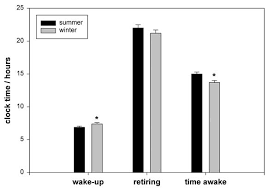On a cold and snowy day, you may want nothing more than to stay in bed until the weather’s a little better.
Turns out, this may be a common sentiment — people in snowier states appear to sleep for a little longer during winter months than those in sunnier states, according to a recent analysis of data from a popular sleep tracking app.
Using the app, called Sleep Cycle, researchers surveyed data from more than 140,000 people in the United States between Jan. 1 and 31 this year.
Users who live in snowy Northwestern states, including Montana, Wyoming, North Dakota, and South Dakota, spent the longest time in bed — 7 hours and 20 minutes a night, on average.
That’s about 13 minutes longer than the average of people who live in the Southeastern states (Tennessee, Mississippi, Alabama, Georgia, South Carolina, and Florida), who spent on average 7 hours and 7 minutes in bed.
During the first half of January, people in Hawaii got the least amount of sleep. There, temperatures averaged in the 70s Fahrenheit (21-26 degrees Celsius), and those using the app got about seven hours of sleep.
People got the most sleep in Colorado and Alaska, where users spent 7 hours and 23 minutes in bed, on average.
Brant Hasler, a sleep expert and assistant professor of psychiatry at the University of Pittsburgh who was not involved in the research, cautioned that the population in the new study is likely not completely representative of each state, because the researchers included only the people who use this particular sleep-tracking app.
In addition, because the study was conducted at one point in time, it cannot say whether people’s sleep habits changed in the wintertime compared to the summertime.
But the finding that people sleep longer under more wintry conditions is generally consistent with what’s known from previous research, Hasler said.
“Many people report that they feel tired and want to sleep more during the winter,” Hasler said. This change in sleep habits is mainly due to the reduction in daylight hours in the wintertime, which affects people’s internal circadian clocks and makes them want to sleep more, he said.
Places farther away from the equator see more of a change in daylight hours from summer to winter. So the amount of sleep that people need in order to feel rested “may vary depending on the time of year and where you live,” Hasler said.
But should people sleep in more during the winter if they feel they need the extra rest? Hasler said that, in general, it is a good idea to accommodate one’s need for sleep.
One way to do so is to go to bed earlier, or if you have flexible work hours, to start your day a little later, Hasler said.
But if you can’t change when you start your day, and you have a hard time getting up in the morning, another option is to try to boost alertness in the morning with a bright light, or “lightbox”, Hasler said.
Such lightboxes, which generally cost $100 or less, were originally developed to help people with seasonal affective disorder (SAD), a type of depression that’s thought to be triggered by a reduction in daylight in the winter. But light boxes may be useful for people without SAD, too. In fact, Hasler said he uses one himself during the winter.
People should expose themselves to the bright light as soon as possible when they wake up in the morning, for 30 minutes to an hour, Hasler said. Those who can’t fit that light exposure in before going to work, Hasler said, might use a lightbox at their desks in the morning, as he does.
Light-box therapy is generally very safe, although some people may experience side effects, including individuals who are prone to migraines, or who have bipolar disorder, Hasler said. It’s worth talking to your doctor about potential remedies if you are having trouble sleeping in the winter, he said.
Winter Sleep vs Summer Sleep
Depending on where you live, you may notice major differences in how you sleep during the summer versus the winter. What causes these differences and what can you do about it to make sure you’re getting enough sleep all year long?
Humans are wired to sleep in certain ways.

Light and darkness are key factors in regulating sleep. Exposure to light stimulates the area in the brain that regulates hormones like melatonin and body temperature.
This, in turn, affects whether we feel sleepy or awake. Melatonin increases sleepiness, and levels increase as the sun sets and stay elevated for about twelve hours.
Most areas of the world experience an increase in daylight hours during the summer and nighttime hours during the winter. Finland, for example, has almost 24 hours of daylight at the summer solstice (check out this synchronized time-lapse video here).
Changing sunrise and sunset times can have an effect on melatonin levels and the time you start to feel sleepy at night. If the sun sets later, you may not start to feel sleepy until later.
While you can’t change the time the sun sets or rises, you can control your sleeping environment. You can eliminate all external light; using blackout curtains and turning off or unplugging all electronic devices that emit light.
Additionally, exposure to sunlight in the morning may help to regulate your melatonin levels and make it easier to fall asleep at night. Try going for a morning walk to start your day.
Of course, there are other factors, such as exposure to artificial light from electronics at night, that can disrupt these natural hormonal rhythms (read more about how light from electronics can disrupt your sleep here). Experts recommend limiting your exposure to all electronic devices at least one hour before your bedtime.

Daytime activity levels affect how long we sleep.
According to the National Sleep Foundation, as little as 10 minutes of aerobic exercises, such as walking or cycling, can dramatically improve the quality of your sleep.
Unfortunately, many of us are less likely to engage in outdoor activities during the colder months of the year. To make matters worse, the winter holiday season may encourage us to eat richer and less healthy foods and then cuddle up on the sofa or even attempt to hibernate through the winter.
People also tend to be more active at night during the summer. Longer days, warmer temperatures, school breaks, and vacations tend to increase our social activity in the summer evenings over winter periods.
Researchers in Belgium found that brain activity levels also change seasonally. Probably based on ancient survival needs, our brains tend to be more active in the summer and less active in the winter.
This study found that attention and concentration in participants peaked during the summer solstice and was lowest near the shortest day of the year.
Summer and winter temps affect how we all sleep.
At night, your core body temperature decreases by two or three degrees to initiate sleep. As the temperature in the air around your drops, so does your core temperature, making it easier to sleep.
Ideal sleeping temperatures are around 65 degrees Fahrenheit. This presents obvious challenges for those living without air conditioning in warmer climates. Experts suggest limiting bedding and sleeping in light bedclothes; additionally, your body will try to lose heat through your hands and feet, so keep them outside of the covers to cool you down.
A 2015 study from UCLA’s Jerry Seigel looked at the sleep of natives people across the world and found that sleep duration may be linked to ambient temperature more than sunrise and sunset. He found that native people slept throughout the night while the temperature dropped and always woke up when the temperature reached the lowest point of the day, even if it occurred after sunrise.








